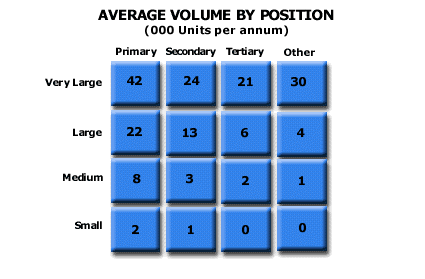Analysis 15: Average Unit Volume By Position
EXHIBITS:

HOW TO INTERPRET THE ANALYSIS: The average volume a supplier might expect when in a relationship with a customer varies significantly depending on the combination of customer size and supplier role. In this exhibit, the average Very Large customer purchases 42,000 units from its Primary supplier, 24,000 from the Secondary supplier, 21,000 from the Tertiary supplier and 30,000 for suppliers in all other roles below Tertiary. On the other hand, the average Small customer purchases only 2,000 units per year from its Primary supplier and 1,000 units from its Secondary. Small customers tend not to use Tertiary and other suppliers.
PURPOSE: This analysis enables the company to estimate the unit volume an incumbent supplier would hold, on average, with the average customer in a given size and role segment. The analysis helps quantify the payoffs from a relationship with a given customer segment.
Average Volume by Position: Industry Examples » APPROACH: The company samples a number of customers of each size category. It divides the customer volume into that given to the primary, secondary, tertiary and other roles. Then it finds an average volume for each position in the customer relationship. This analysis is the result of estimates developed by the marketing and sales staffs. An alternative approach to estimating the average volume by position in the customer relationship is to use the percentages shown in Analysis 14 and to multiply those by the average size of the customer size segment. For example, Very Large customers in Analysis 14 offer 36% of their total relationship to the primary supplier (18% of the total market divided by 50% of the total market). Assuming an average Very Large, customer buys 116,000 short tons a year from all suppliers, the primary role position with the average Very Large customer is worth 42,000 short tons per year to the incumbent. One use for this analysis is to rank order the attractiveness of each average position in the marketplace in order to help the company determine the importance of developing new relationships with unknown customers of a given size. In the example above, a primary position with a Large customer is more valuable than the average tertiary position with a Very Large customer and nearly as valuable as the secondary position. The term valuable refers to the sales volume the average relationship will provide. In this industry, the secondary position with the next larger size segment, on average, provides more volume than does the primary position of the size below it. For example, the secondary position with the average Very Large customer provides more volume than does the primary position with the average Large customer. Similarly, the secondary position with the average Large customer provides more unit volume than does the primary position with the average Medium customer. Part or all of these sales volume differences may be offset by the higher prices paid by the smaller sized customer. |
|
Recommended Reading |
| For a greater overall perspective on this subject, we recommend the following related items:
Analyses:
|
||||||||||||
Symptoms and Implications: Symptoms developing in the market that would suggest the need for this analysis.
|
||||||||||||
Perspectives: Conclusions we have reached as a result of our long-term study and observations.
|
